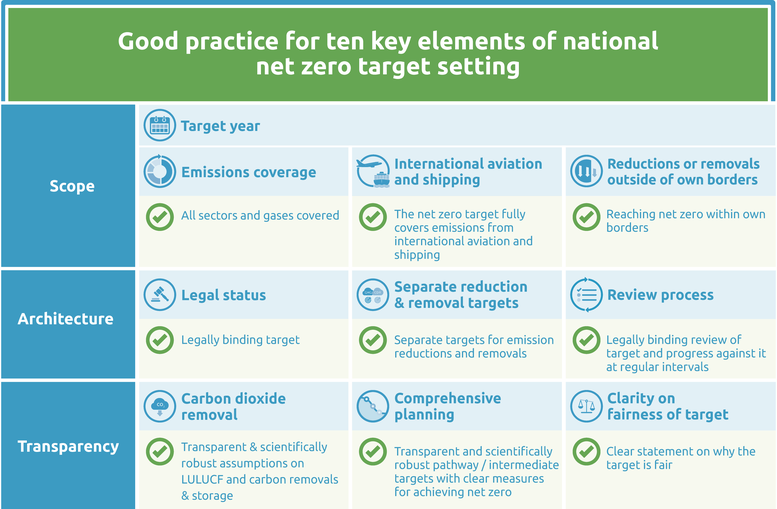Net zero targets
Summary
We evaluate the net zero target as: Average.
Canada passed the Canadian Net-Zero Emissions Accountability Act in June 2021, which enshrines its 2050 net zero target into law. The act also mandates the setting of intermediary targets at five-year intervals (2030, 20235, 2040, 2045), at least a decade in advance of each target, and the requirement to develop emissions reduction plans for these targets. The emissions reduction plan for the 2030 target, including an interim emissions reduction objective for 2026, is due by the end of 2021.
While Canada’s Net Zero Act has some positive measures, it does not follow good practice on a number of other aspects, such as including emissions from international aviation and shipping into its target or providing any detail on how it will use the land sector or carbon dioxide removal as part of meeting its target.
CAT analysis of net zero target
Ten key elements
Scope
- Target year – Canada aims to reach net zero by 2050, however, nothing in its Net-Zero Act precludes achieving net zero emissions before 2050.
- Emissions coverage – The target covers all GHG emissions and all sectors of the economy (excluding international bunkers).
- International aviation and shipping – The target does not cover international aviation and shipping. However, under the Net-Zero Act, it is possible to amend the methodology used (currently set as that used for the national GHG inventory), so it may be possible to expand that coverage in future regulations if the government so decides.
- Reductions or removals outside of own borders – Canada plans to reach net zero emissions through domestic action.
Target architecture
- Legal status – Canada passed its net zero target into law in June 2021 (Government of Canada, 2021f).
- Separate reduction & removal targets – Canada does not have separate emissions reduction and removal targets.
- Review process – Canada must prepare at least one progress report for each five-year intermediary targets as well as an assessment report after that particular target year has passed to evaluate whether the target was achieved. There is no binding obligation to achieve the target, only to explain why the target was not reached and to provide a description of the actions being taken in the case of failure.
Transparency
- Carbon dioxide removal – There is no transparency at the moment on whether and how Canada will use land sector (LULUCF) or other carbon dioxide removals (CDR) as part of its target. Investment tax credits for carbon capture and storage will come into force in 2022 (Government of Canada, 2021c). The government hopes to reduce at least 15MtCO2 annually through this measure. The relationship between these reductions and meeting the 2050 target is unclear. Under the Net-Zero Act, the government must develop an emissions reduction plan to meet the target. We expect further details to be provided at that time.
- Comprehensive planning – Under the Net-Zero Act, the government must set emission reduction targets at five year intervals towards to the 2050 target, starting in 2030. In February 2021, the government established an advisory body to assist it in developing net zero pathways (Government of Canada, 2021i). The 2021 Budget includes five years of funding for Environment and Climate Change Canada to develop and apply a ‘climate lens’ to federal decision-making process (Government of Canada, 2021c). It must also prepare at least one progress report for each of the target years.
- Clarity on fairness of target – Canada has not provided an explanation for why its net zero target is a fair contribution to meeting the Paris Agreement’s 1.5°C goal. Under the Net Zero Act, the government must consider Canada’s international commitments under the Convention and Paris Agreement.
Good practice
The Climate Action Tracker has defined the following good practice for all ten key elements of net zero targets. Countries can refer to this good practice to design or enhance their net zero targets.
Further analysis
Latest publications
Stay informed
Subscribe to our newsletter







